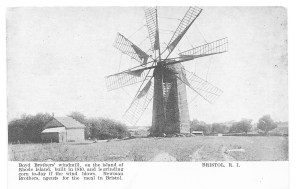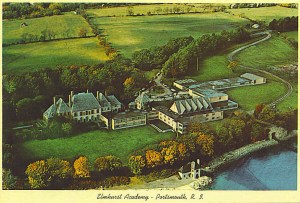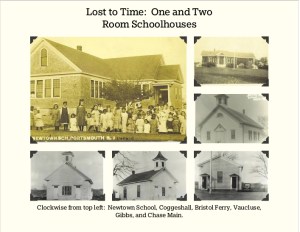Middletown may have the windmill on its town seal, but Portsmouth had its share of wind powered and gasoline powered grist mills. Butts Hill was known as “Windmill Hill” on some of our oldest maps. Quaker Hill had up to three windmills at one time or another. The gristmills were part of the fabric of Portsmouth society, but as more grain was imported from the American West, local farmers turned to growing vegetables for market. In 1901 five mills were still turning in Portsmouth. What happened to our windmills? You can see two of them in preserved in Middletown. The mill now at Prescott Farm made the rounds of a few locations before being restored by the Newport Restoration Foundation. It was built in Warren in 1813, moved to the Highlands area of Fall River and then moved by Robert Sherman to Quaker Hill. Articles in the Newport Mercury from 1871 place the mill in Portsmouth and report that the mill was severely damaged by a storm. Later Benjamin Hall bought the mill and got it back in operation at Lehigh Hill off of East Main Road. The mill passed through other hands and was damaged in the 1938 hurricane. In 1968, Doris Duke and the Newport Restoration Foundation purchased the mill and painstakingly unassembled it for a move down to Prescott Farm. Unlike many of the other mills, Boyd’s Mill was built in Portsmouth and stayed at he corner of Mill Lane and East Main Road for over a hundred years. The wood for the mill, however, did do some traveling. Portsmouth was still recovering from the devastation to its trees by the British occupying forces during the Revolutionary War. The wood for the mill construction was cut in Wickford and ferried across the bay. Some of the wood was recycled from owner John Peterson’s damaged schooner. After five years the mill transferred into the hands of the Boyd family. In its original construction, Boyd’s mill had four panes. In 1901 one of the Boyds converted the mill to the eight panes we see now. Later it was fitted for gasoline power. The Middletown Historical Society has moved the mill to Paradise Park and has restored the mill to operation. Portsmouth maps from 1907 show a mill on the Thurston property just north of Union Street. It was originally built in Little Compton but was moved to Portsmouth in 1896. The Portsmouth Historical Society has a painting of a Glen Mill with the Thurston Mill in the background. Thurston’s Mill may have been destroyed in a fire in the 1950s. Windmills are an important part of Portsmouth’s history. We can be grateful that some of them still exist even if they have been lost to Portsmouth and moved to Middletown.
Portsmouth Windmills: Lost to Time
April 30, 2014
Glen Area, Lost to Time, Portsmouth History 1 Comment
Lost to Time: Elmhurst Academy
April 5, 2014
Glen Area, Lost to Time, Portsmouth History Elmhurst Academy 2 Comments
With the demolition of the Elmhurst School during the winter of 2014, two schools met their end. Elmhurst School was preceded by Elmhurst Academy, a Catholic girl’s school.
By 1960 Reginald Taylor had inherited Glen Farm and he was looking for ways to sell the property. The Sisters of the Sacred Heart had a school in Providence called the Convent of the Sacred Heart, Elmhurst. The buildings were in tough shape and they made the decision to buy this waterfront area of Glen Farm to make a new home for their school. Reginald Taylor sold the Manor house and 43 acres to Elmhurst Academy of the Sacred Heart during a meeting at the Biltmore Hotel in New York City. The Manor House served as a dormitory for boarding students. Added to the house were classrooms, a chapel, a convent and a dining hall.
Education at Elmhurst began with First grade and went through high school. Most of the 22 children in the primary grades had older sisters in the school. In 1963 there were 23 nuns and a lay staff of 15 people. Ninety-five percent of the students went on to college. A 1963 Providence Journal feature article quoted Reverend Mother Husson as saying that at Elmhurst “Our ideal is to educate girls to be wives and mothers, women who can fulfill their first responsibility and who, nowadays, can take their place in the world if necessary.”
Two graduates of Elmhurst Academy, Suzanne Santa and Mary O’Connell Cummings, shared their memories of Elmhurst as a Catholic girls school. Suzanne was a boarding student and she remembers the day starting at 6 AM. They dressed in their day uniform of plaid skirt, dark blazer and big ugly shoes. There were actually four uniforms for boarding students – one for school, one for gym, one for dinner and a white uniform for special occasions. Their rooms at the Manor House varied through the year. Half the time they roomed with three others in one of the Taylor bedrooms and the other half year they shared a room that was in the servant’s quarters. After mass in the chapel they would go to study hall (where our kindergarten is now) and quietly studied. School began at 8 AM and ended at 3:30 PM, but there were sports after school. Elmhurst offered field hockey and sailing lessons. Most boarders went home on weekends, but some stayed almost year round at Elmhurst. On weekends they would study, play tennis and practice for chorus. Food poisoning (they called it the Green Death) was sometimes a problem, but a nurse or doctor was on hand to help.
Day student Mary Cummings started high school at Elmhurst the year it opened in Portsmouth (1961). Mary’s report card shows that they were graded on personal appearance, courtesy and cooperation in school discipline as well as traditional subjects such as French, English and science. Classes were about 50 minutes long and there were bells that signaled the change in classes. They practiced curtseying and had to curtsey whenever they passed a nun.
In 1995 an Elmhurst Elementary student interviewed Mother General Whalen. She gave us an idea of what life was like for the sisters who lived in the convent. They were “cloistered” and lived apart in their own community. Their small sleeping quarters are located around the chapel. They awoke at 5 AM for a one hour meditation in the chapel. Meditation was followed by singing prayers in Latin. They then went to breakfast and started their teaching day. Their teaching day ended at 4:30 PM, but in the evening they graded papers or quietly prayed for hours.
In 1972 Elmhurst Academy closed its doors. The Town of Portsmouth bought the property for $1,350,000. The town used the school as Elmhurst Elementary School until that school was closed in 2010. More on Elmhurst School in a later blog.
The Elmhurst Reuse Committee pondered what to do with the school property and the recommendation was to tear down the school building. This was done winter 2014. It is my hope is that the townspeople of Portsmouth will enjoy this historic property for generations to come.
One and Two Room Schools – Lost to Time
April 5, 2014
Portsmouth History Leave a comment
Thanks to the efforts of the Hall family and the Portsmouth Historical Society, one of the original one-room schoolhouses in Portsmouth has not been lost to time. On the grounds of the Portsmouth Historical Society museum, the Southermost School provides a glimpse of Portsmouth School Days in the 1700s. Around 1730 there were two schools in town – the Southermost by the corner of Union and East Main and the Northermost School which was located (logically enough) in the north of town (near where the post office is today).
Around 1860 the town was large enough to divide into eight districts. Southermost and Northermost Schools were retired. Southermost served as a harness shed on the Hall farm on Union Street. Prudence Island’s one room school house is one of those original eight. Bristol Ferry, Chase Main (near the location of Melville School), McCorrie School (Schoolhouse Lane), Vaucluse (Braman’s Lane near Wapping Rd.), Gibbs School (Union St. near Jepson Lane) and a school that served the coal mine area were among these one room schools.
As the school system outgrew the one-room schools, schools that had two or three rooms were built. Newtown School on Turnpike, Quaker Hill School (the Administration Building today) and Coggeshall School on East Main began to handle different grades. As the town grew older students went to Anthony School and Anne Hutchinson School held a variety of grades. Along the way the schools were repurposed or moved. Coggeshall School received a large addition that is used by the Aquidneck Island Christian Academy today.
Here is a 200 year old list of Rules and Punishment posted at Southernmost School. Imagine if they were the rules at school today!
- Boys and girls playing together – 1 lash
- Fighting at School – 5 lashes
- Quarreling at school – 3 lashes
- Climbing for every foot over 3ft up a tree – 1 lash
- Telling tales out of school – 8 lashes
- Giving each other ill names – 3 lashes
- Misbehaving to girls – 10 lashes
- Leaving school without leave of the teacher – 4 lashes
- Wearing long fingernails – 2 lashes
- Boys going to the girls’ play place – 3 lashes
- Girls going to the boys’ play place – 2 lashes
- For every word you miss on your heart lessons without a good excuse – 1 lash
- For not saying yes or no sir or yes or no marm – 2 lashes
- Telling lies – 7 lashes
- Swearing at school – 9 lashes.




